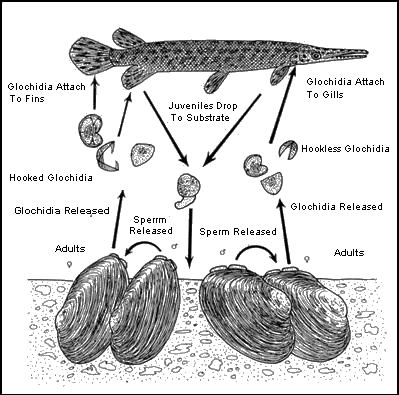- Get Involved
- Post observations to the Freshwater Mussels of Texas Project on iNaturalist
- Learn More
Texas Nature Trackers
Texas Parks and Wildlife Department
4200 Smith School Road
Austin, TX 78744
(800) 792-1112 ext. 8062
tracker@tpwd.texas.gov
Texas Mussel Watch: Texas Freshwater Mussel Biology
Freshwater mussels, the vacuum cleaners of the aquatic ecosystem, feed by filtering algae and small particles from the water. Larvae are released by the female mussel and must locate a certain fish species or die. They usually attach to the host fish's gills or fins where they remain for a few weeks or months. Larval mussels rarely harm infected fish under natural conditions. When they become juveniles, they drop back to the substrate for the cycle to begin again. If essential fish species are removed from the habitat, mussels will not be able to reproduce.

Adult mussels can range from less than one inch in length to nearly 12 inches long. Some species have thin shells and a life-span of only 5 or 6 years, while others have thick shells and can live well over 50 years. Shells vary both on the inside and outside of mussels, depending upon the mussel species. Color, texture, and shape variations in shells are used to help identify different types of mussels.
Freshwater mussels have been collected by commercial musselers for the cultured pearl industry. A cultured pearl is formed by taking a round core from the shell of some of our larger species of freshwater mussels and inserting that core into a clam. Freshwater pearls have also been collected by musselers. One species, the Tampico pearlymussel is known to produce the rare Concho River Pearl.
Mussels are often the first species to vanish when environmental conditions change or decline. As filter feeders, mussels concentrate substances that are dissolved in the water. Mussel tissues can be examined to check for many toxic chemical pollutants of our rivers, lakes, and streams. Healthy mussel populations mean purer water for humans and countless aquatic plants and animals.
Reasons for decline in freshwater mussel populations include:
- Changes in flow rates of rivers and streams due to droughts, floods, or building of dams;
- Increased deposition of soft silt due to excessive run-off;
- Scouring of stream beds during storm events;
- Increased amounts of aquatic vegetation;
- Lack of suitable native fish hosts for larval stage;
- Aquatic contaminants; and,
- Introduction of exotic species.
